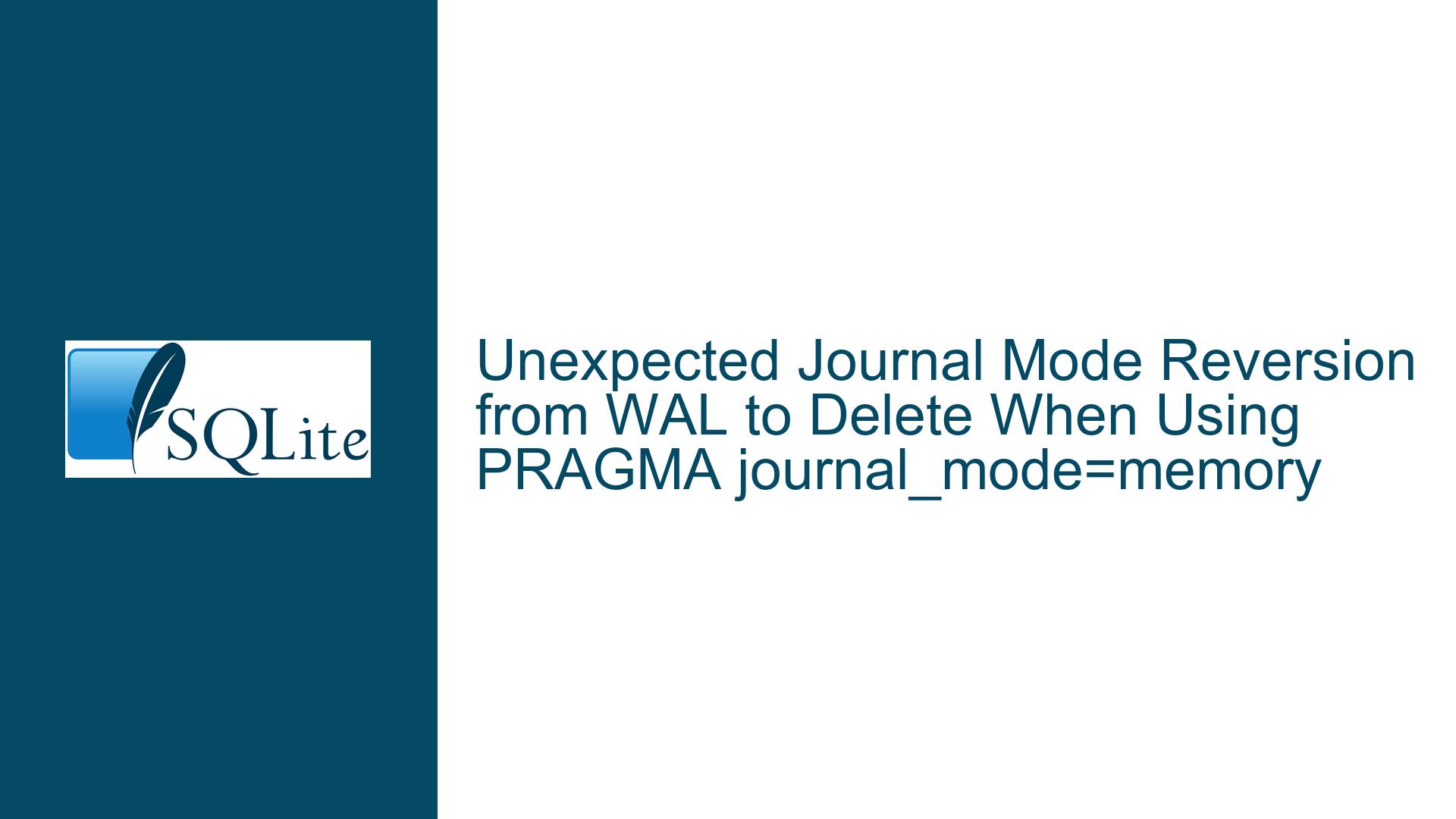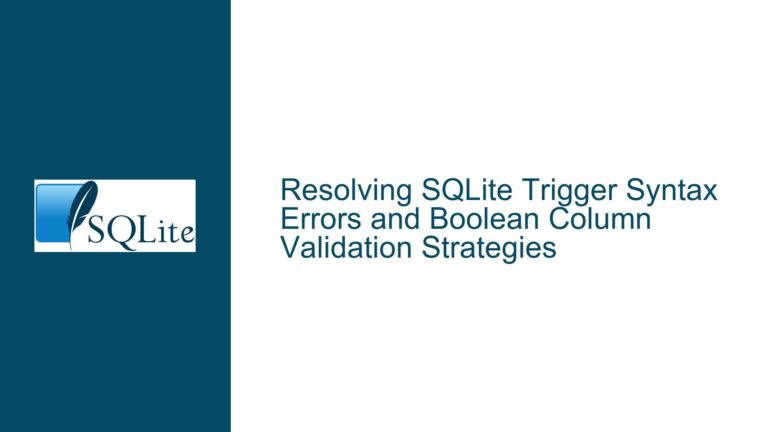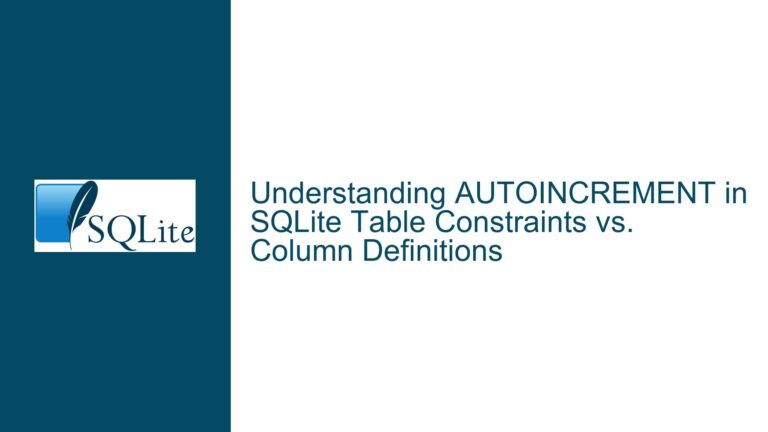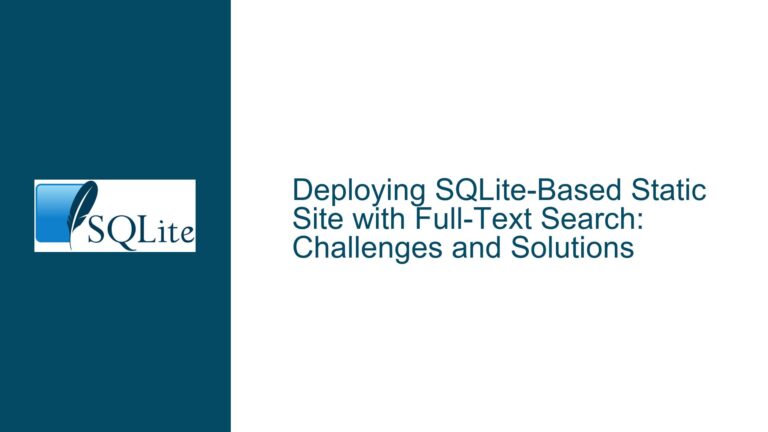Unexpected Journal Mode Reversion from WAL to Delete When Using PRAGMA journal_mode=memory
Journal Mode Persistence Behavior in SQLite: From Configuration to Operational Impact
SQLite’s journaling subsystem plays a critical role in ensuring atomicity and durability during database transactions. A recurring point of confusion arises when users attempt to configure non-WAL journal modes (e.g., MEMORY, TRUNCATE, or PERSIST) after disabling Write-Ahead Logging (WAL). This guide dissects the mechanics of journal mode transitions, explains why PRAGMA journal_mode=MEMORY causes unexpected reversion to DELETE mode upon database reconnection, and provides actionable solutions for predictable configuration management.
Journal Mode Configuration Lifecycle: Persistent vs. Session-Specific Settings
Persistent vs. Ephemeral Journal Modes
SQLite treats the WAL journal mode as a persistent database-level attribute stored in the database file header. When a database is opened in WAL mode, this setting is preserved across sessions. All other journal modes (DELETE, TRUNCATE, MEMORY, PERSIST) are connection-specific and do not modify the underlying database configuration. Attempting to switch from WAL to any non-WAL mode (e.g., MEMORY) only affects the current connection. Subsequent connections revert to the default rollback journal mode (DELETE) because the database file no longer has the WAL flag set.
Operational Phases of Journal Mode Transitions
- Initialization Phase: A new database defaults to
DELETEjournal mode. - WAL Activation:
PRAGMA journal_mode=WALwrites theWALflag to the database header, making it persistent. - Non-WAL Transition: Executing
PRAGMA journal_mode=MEMORYduring the same session disablesWALmode for that connection but does not update the database header. TheWALflag is cleared, and the journal mode becomesMEMORYtemporarily. - Subsequent Connection: On reopening the database, SQLite detects the absence of the
WALflag and initializes the connection with the defaultDELETEjournal mode.
Why This Behavior Is Counterintuitive
Users often assume that setting journal_mode=MEMORY after disabling WAL will persist the MEMORY configuration. However, SQLite’s design enforces that only WAL mode modifies the database file’s persistent state. Non-WAL modes are transient and bound to the lifetime of the connection. This creates a "reset" effect when reopening the database, as the system falls back to the default DELETE mode.
Root Causes of Journal Mode Reversion and Configuration Conflicts
1. WAL Mode’s Exclusive Persistence Mechanism
The WAL journal mode is the only one that alters the database file’s header. When a user disables WAL (e.g., by setting journal_mode=MEMORY), SQLite removes the WAL flag from the header. Subsequent connections interpret the absence of this flag as an instruction to use the default rollback journaling mechanism (DELETE). Non-WAL journal modes lack a comparable persistence mechanism, making their configurations session-bound.
2. Default Rollback Journaling Behavior
SQLite’s rollback journal subsystem defaults to DELETE mode unless explicitly overridden during connection initialization. This default is hardcoded and cannot be altered through prior session configurations. Applications expecting non-DELETE rollback journal modes must reconfigure them at every connection.
3. Misinterpretation of PRAGMA journal_mode Semantics
The PRAGMA journal_mode command operates in two distinct contexts:
- Persistent Configuration: Only
PRAGMA journal_mode=WALmodifies the database header. - Session Configuration: All other modes (
MEMORY,TRUNCATE, etc.) apply only to the current connection.
Users accustomed to persistent settings for other parameters (e.g., PRAGMA page_size) may incorrectly assume that journal_mode behaves similarly. This mismatch between expectation and implementation leads to unintended mode reversion.
4. Undocumented Implicit WAL Deactivation
Switching from WAL to a non-WAL journal mode implicitly deactivates the WAL flag without warning. SQLite’s documentation does not explicitly state that this action resets the persistent configuration, leaving users unaware of the need to reapply non-WAL settings on subsequent connections.
Resolving Journal Mode Inconsistencies: Configuration Strategies and Best Practices
1. Explicit Journal Mode Reinitialization
Since non-WAL journal modes are transient, applications must set the desired mode at the start of every database connection. For example:
-- Reopen connection
PRAGMA journal_mode=MEMORY;
Automate this process by integrating the PRAGMA command into connection-handling routines or ORM initialization scripts.
2. WAL Mode Retention with Hybrid Strategies
If WAL mode is preferred but MEMORY journaling is required for specific operations, retain WAL mode and adjust temporary settings per transaction:
PRAGMA journal_mode=WAL; -- Persistent configuration
BEGIN TRANSACTION;
PRAGMA journal_mode=MEMORY; -- Temporary override for current transaction
-- Perform operations
COMMIT;
-- Journal mode automatically reverts to WAL for next transaction
This approach preserves the WAL flag in the database header while allowing temporary use of MEMORY journaling.
3. Database Configuration Profiling
Implement startup checks to validate the active journal mode and enforce desired configurations:
-- During connection initialization
SELECT pragma_journal_mode FROM pragma_journal_mode;
-- If result is not 'wal', enforce application-specific policy
PRAGMA journal_mode=MEMORY;
Use conditional logic to handle deviations from expected configurations.
4. Documentation-Driven Configuration
Refer to SQLite’s authoritative documentation on journal modes:
- WAL Mode Persistence: Confirmed in SQLite Documentation: WAL Mode.
- Transient Nature of Non-WAL Modes: Implied but not explicitly stated in PRAGMA journal_mode.
Clarify these behaviors in internal documentation to align team expectations with SQLite’s actual behavior.
5. File Handle and Connection Pooling Adjustments
When using connection pools, ensure that each pooled connection reinitializes the journal mode. For example:
# Python SQLite connection pool example
import sqlite3
from contextlib import contextmanager
@contextmanager
def get_connection():
conn = sqlite3.connect('test.sqlite')
conn.execute('PRAGMA journal_mode=MEMORY;')
yield conn
conn.close()
6. Avoiding Implicit WAL Deactivation
To prevent accidental WAL flag removal, isolate WAL and non-WAL operations in separate database files or enforce runtime checks:
-- Prevent accidental WAL deactivation
CREATE TRIGGER enforce_wal_mode BEFORE PRAGMA journal_mode ON database
WHEN (new.journal_mode != 'wal')
BEGIN
SELECT RAISE(ABORT, 'WAL mode cannot be disabled');
END;
Note: This pseudocode illustrates the concept; actual trigger implementation would require runtime interception.
7. Cross-Platform Consistency Checks
Test journal mode behavior across all target platforms (Windows, Linux, macOS, mobile OSes). File locking and memory management differences can affect MEMORY and WAL mode reliability.
8. Long-Term Monitoring and Logging
Log journal mode changes and connection events to identify unintended configuration resets:
-- Log journal mode changes to a dedicated table
CREATE TABLE journal_log (
timestamp DATETIME DEFAULT CURRENT_TIMESTAMP,
mode TEXT
);
-- Trigger to log changes
CREATE TRIGGER log_journal_mode_change AFTER PRAGMA journal_mode
BEGIN
INSERT INTO journal_log (mode) VALUES (new.journal_mode);
END;
9. Alternative Storage Engines and Extensions
For applications requiring persistent non-WAL configurations, consider SQLite extensions or forks that enhance journal mode persistence. Verify compatibility with upstream SQLite before deployment.
10. Leveraging SQLite’s URI Filename Feature
Specify journal modes directly in the database URI to enforce configurations at connection time:
-- Open database with URI filename specifying journal mode
sqlite3 'file:test.sqlite?journal_mode=MEMORY'
This method ensures the journal mode is set immediately upon connection, bypassing the need for post-connection PRAGMA statements.
By understanding SQLite’s journal mode persistence rules and adopting proactive configuration management, developers can eliminate unexpected reversion to DELETE mode and maintain consistent transactional behavior across database sessions.






